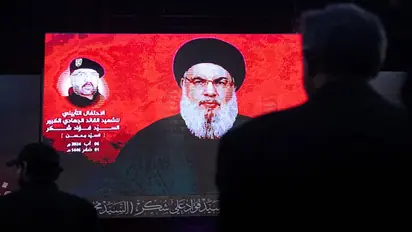Explained: How Iranian spy tip-off helped Israel kill Hezbollah chief Nasrallah in Beirut stronghold

Synopsis
The chilling operation unfolded in the heart of Beirut's densely populated southern suburbs, where Nasrallah’s underground stronghold lay hidden. A high-ranking Iranian mole, deeply embedded within Hezbollah’s ranks, reportedly provided the decisive information that led to this daring strike, according to reports from Le Parisien. The intelligence was razor-sharp, giving Israel an unparalleled chance to eliminate the head of the Shiite militant group.
In a dramatic turn of events that has shaken the Middle East, Hezbollah's iconic and long-feared leader, Sayyed Hassan Nasrallah, met his end in a precisely executed Israeli airstrike. The notorious figure, whose shadow has loomed over Lebanon for decades, was targeted after Israeli intelligence received a covert tip-off just hours before the strike.
The chilling operation unfolded in the heart of Beirut's densely populated southern suburbs, where Nasrallah’s underground stronghold lay hidden. A high-ranking Iranian mole, deeply embedded within Hezbollah’s ranks, reportedly provided the decisive information that led to this daring strike, according to reports from Le Parisien. The intelligence was razor-sharp, giving Israel an unparalleled chance to eliminate the head of the Shiite militant group.
The mole's tip-off arrived in the afternoon, warning Israeli forces that Nasrallah would be present at Hezbollah’s fortified underground command center in Dahieh — a heavily protected labyrinth of six buildings. The Israeli Defense Forces (IDF) mobilized swiftly, preparing their state-of-the-art F-35 fighter jets armed with devastating bunker-busting bombs. Their target: Nasrallah, a man who had eluded them for over 30 years.
"The Israelis went all out; they didn’t want to miss their target,” said a Lebanese security source, who chose to remain anonymous following the attack. The high-risk operation was a culmination of years of strategic patience, aimed at a man who had orchestrated Hezbollah’s ascension as Iran's powerful proxy in its relentless battle against Israel since the 1990s.
Nasrallah's underground command center, once considered impregnable, had been a long-standing target for Israeli forces. But this time, they had the upper hand — the mole’s intelligence was ironclad, and the timing impeccable.
At the same time Nasrallah was arriving at his command center, mourners gathered just a few kilometers away in the Haret Hreik neighborhood for the funeral of Mohamed Hussein Srour, Hezbollah’s drone unit commander, who had been killed in an Israeli strike the day before. The tension in the air was palpable, but little did they know that their leader was next in Israel’s crosshairs.
Then, at precisely 1:30 pm IST (11:00 am in Lebanon), the skies over Dahieh erupted. Israeli jets, hovering just beyond Beirut’s airspace, launched their lethal payload. The bunker-busting bombs sliced through layers of concrete and steel, hitting their target with devastating accuracy. In moments, Hezbollah’s once-impenetrable fortress was reduced to smoldering ruins.
Nasrallah, the man who had promised to bring down Israel, was no more.
The Israeli military wasted no time in claiming responsibility. In a swift and terse statement posted on X (formerly Twitter), the IDF proclaimed: "Hassan Nasrallah will no longer be able to terrorize the world." Hours later, Hezbollah issued its own somber statement: “Sayyed Hassan Nasrallah... has joined his great, immortal martyr comrades whom he led for about 30 years.”
Nasrallah’s death wasn’t the only blow dealt by Israel. Nabil Kaouk, another senior Hezbollah commander, was also killed in a separate Israeli airstrike, underscoring Israel’s relentless campaign targeting the militant group's leadership. Though Hezbollah remained silent on Kaouk’s death, mourning tributes flooded social media from supporters.
These airstrikes come amid a period of fierce conflict between Hezbollah and Israel, with both sides sustaining significant casualties. Lebanon’s health ministry reported that 33 people were killed in Israeli strikes on Saturday alone. Over the past two weeks, more than 1,000 people have lost their lives, with over 6,000 injured, although the ratio of civilian to combatant casualties remains unclear.
For Hezbollah, Nasrallah's assassination is an unparalleled loss, striking at the very heart of the group’s leadership. Just days before his death, Nasrallah had acknowledged in a televised speech that Hezbollah had suffered serious setbacks, especially after Israeli forces successfully intercepted their communications and launched a devastating series of attacks. Explosive-rigged devices, disguised as booby-trapped pagers and walkie-talkies, had killed 37 Hezbollah fighters and wounded thousands more.
“Unprecedented,” Nasrallah had admitted, though his defiance was unshaken as he vowed revenge. Hezbollah, he warned, would strike back with "tough retribution and just punishment, both in expected and unexpected ways."
As investigators sift through the rubble and more details about the mole's role come to light, Israel’s intelligence triumph becomes even more apparent. The airstrike that ended Nasrallah’s life signals a pivotal moment in the decades-long conflict between Israel and Hezbollah, raising the stakes for future confrontations.
Check the Breaking News Today and Latest News from across India and around the world. Stay updated with the latest World News and global developments from politics to economy and current affairs. Get in-depth coverage of China News, Europe News, Pakistan News, and South Asia News, along with top headlines from the UK and US. Follow expert analysis, international trends, and breaking updates from around the globe. Download the Asianet News Official App from the Android Play Store and iPhone App Store for accurate and timely news updates anytime, anywhere.